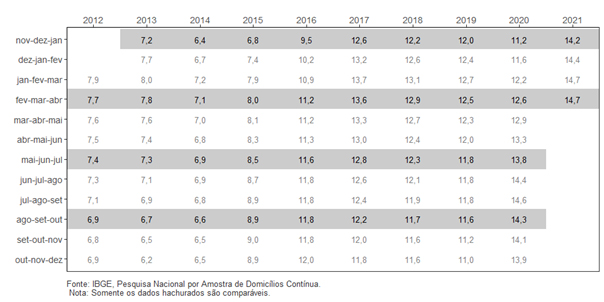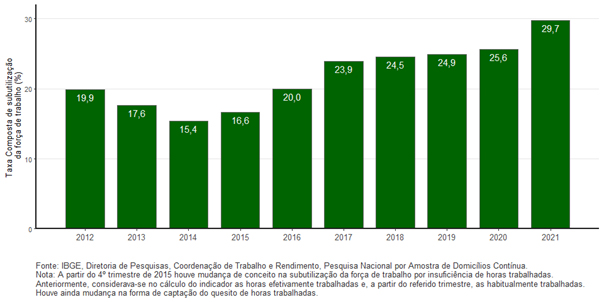Continuous PNAD: unemployment rate is 14.7%, underutilization rate is 29.7% in quarter ending in April
June 30, 2021 09h00 AM | Last Updated: July 01, 2021 05h28 PM
The unemployment rate (14.7%) of the moving quarter between February and April 2021 remained a record in the time series, started in 2012, with a rise of 0.4 percentage points (p.p.) over the quarter from November 2020 to January 2021 (14.2%) and a rise of 2.1 p.p. over the same quarter of 2020.
| Indicator/Period | Feb-Mar-Apr 2021 | Nov-Dec-Jan 2021 | Feb-Mar-Apr 2020 |
|---|---|---|---|
| Unemployment rate | 14.7% | 14.2% | 12.6% |
| Underutilization rate | 29.7% | 29.0% | 25.6% |
| Usual real earnings | R$2,532 | R$2,577 | R$2,571 |
| Change of the usual real earnings in relation to: | -1.7 (stable) | -1.5 (stable) | |
The unemployed population (14.8 million persons) grew 3.4% (more 489 thousand unemployed persons) over the quarter from November 2020 to January 2021 and increased 15.2% (more 1.9 million persons) over the same moving quarter last year (12.8 million persons).
The employed population (85.9 million persons) remained stable against the previous moving quarter and fell 3.7% (less 3.3 million persons) against the same quarter in 2020.
The employment-population ratio – percentage of employed persons at working age – hit 48.5%, remaining stable in relation to the moving quarter from November 2020 to January 2021 (48.7%) and retreating 3.1 p.p. in relation to the same quarter of 2020 (51.6%).
The composite underutilization rate (29.7%) rose 0.7 p.p. over the previous moving quarter (29.0%) and increased 4.1 p.p. over the same quarter of 2020 (25.6%).
The underutilized population (33.3 million persons) grew in both comparisons: 2.7% (more 872 thousand underutilized persons) over the previous moving quarter and 16.0% (more 4.6 million persons) in relation to the same quarter of 2020.
The population out of the workforce (76.4 million persons) remained stable against the previous quarter and grew 7.7% (5.5 million persons) against the same quarter of 2020.
The discouraged population (6.0 million persons) remained stable over the previous moving quarter and grew 18.7% against the same period of 2020.
The percentage of discouraged persons in the workforce or discouraged (5.6%) remained stable over the previous moving quarter (5.6%) and increased 0.9 p.p. over the same period of 2020 (4.7%).
The number of persons employed in the private sector with a formal contract – excluding domestic workers – was 29.6 million persons, remaining stable against the previous quarter and dropping 8.1% (less 2.6 million persons) against the same period in 2020.
The number of persons employed without a formal contract in the private sector (9.8 million persons) remained stable in relation to the previous quarter and dropped 3.7% (less 374 thousand persons) against the same quarter of 2020.
The number of self-employed workers (23.8 million) rose 1.5% in the comparison with the previous quarter (352 thousand more persons) and 2.8% in relation to the same quarter of 2017 (650 thousand more persons).
The category of domestic workers (5.0 million persons) remained stable against the previous quarter, yet it retreated 10.4% (-572 thousand persons) against the same period last year.
The employed population (85.9 million persons) remained stable against the previous moving quarter and fell 3.7% (less 3.3 million persons) against the same quarter in 2020. The number of employers with CNPJ (3.1 million) was the lowest one in that time series, started in 2016, remaining stable against the previous moving quarter and falling 10.2% (less 353 thousand persons) in the annual comparison.
The informality rate hit 39.8% of the employed population, representing a contingent of 34.2 million informal workers. That rate had been 41.1% in the previous quarter and 38.8% in the same quarter last year.
The usual real earnings (R$2,532) remained stable in both comparisons. The usual real wage bill (R$212.3 billion) held steady against the previous moving quarter and dropped 5.4% over the same quarter last year (less R$12.1 billion).
Unemployment Rate - Brazil - 2012/2021

In the moving quarter between February and April 2021, the workforce - employed and unemployed persons -, estimated at 100.7 million, remained stable against the previous moving quarter and retreated 1.3% (less 1.4 million persons) against the same quarter of 2020.
The number of persons employed in Trade, repair of motor vehicles and motorcycles dropped 2.3% (less 373 thousand persons); the other activity groups remained stable against the quarter from November 2020 to January 2021.
Compared with the same moving quarter of 2020, six groups dropped: General Industry (-4.3% or less 497 thousand persons), Trade, repair of motor vehicles and motorcycles (-6.7% or less 1.1 million persons), Transportation, storage and mailing (-8.3% or less 393 thousand persons), Housing and food (-17.7% or less 871 thousand persons), Other services (-13.9% or less 660 thousand persons) and Domestic services (-10.1% or less 562 thousand persons). The only rise was in Agriculture (6.5% or more 532 thousand persons). The other groups remained stable.
The group of those employed in the public sector – including statutory servants and military – remained stable in both comparisons.
The number of time-related underemployed persons (7.2 million persons) increased 6.1% (more 413 thousand persons) against the previous quarter and grew 18.3% (more 1.1 million persons) against the same quarter of 2020.
Composite underutilization rate - Quarters from February to April - 2012 to 2021 (%)

Concerning the usual real average earnings, the group of Trade, repair of motor vehicles and motorcycles reduced (-4.0% or less R$80)and the other groups remained stable against the previous quarter.
Compared with the same quarter of 2020, five groups reduced: Industry (-7.3%, or less R$191); Construction (-8.4%, or less R$165); Trade, repair of motor vehicles and motorcycles (-5.7%, or less R$117); Transportation, storage and mailing (-9.2%, or less
R$219) and Domestic services (-4.9%, or less R$48). The other groups remained stable.
Among the employment types, all the positions (Persons employed in the private sector, Persons employed in the public sector, Domestic workers, Employers and Self-employed persons) remained stable against the previous quarter. In relation to the same quarter a year ago, the earnings of Domestic workers reduced (-4.9% or less R$48). The other positions remained stable.

